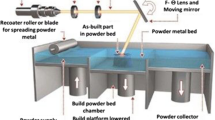Abstract
Throughout the plastic deformation of sheet metal axisymmetric shape parts such as hemispherical products using the spinning process, the sheet metal experiences intensive stresses and strains. Therefore, producing sheet metal pieces using this technique requires substantial skills. The study and analysis of stresses, strains, and other parameters affecting the process by means of numerical strategies or experimental setups help to better understand the stress–strain state and how the material is deformed during the process. In this study, a 3D finite element model is developed using Abaqus/Explicit solver to systematically analyze the spinning of hemispherical sheet metal parts in both single and multi-pass spinning operations and were compared with the results obtained from the experiments to confirm their validity. During the process, stresses, strains, and wall thickness distribution of the samples were investigated and compared with relevant experimental outputs. Also, the geometrical condition of the final product and applied forces to the workpiece were examined. The results obtained from the two operations (single-pass and multi-pass) indicate adequate consistency between the results of the simulation models and the experiments.



























Similar content being viewed by others
References
Wong, C. C., Dean, T. A., & Lin, J. (2003). A review of spinning, shear forming and flow forming processes. International Journal of Machine Tools and Manufacture, 43, 1419–1435.
Music, O., Allwood, J. M., & Kawai, K. (2010). A review of the mechanics of metal spinning. Journal of Materials Processing Technology, 210, 3–23.
Kong, Q., & Yu, Z. (2017). A study of severe flange wrinkling in first-pass conventional spinning of hemispherical part. The International Journal of Advanced Manufacturing Technology, 93, 3583–3598.
Liu, J. H., Yang, H., & Li, Y. Q. (2002). A study of the stress and strain distributions of first-pass conventional spinning under different roller-traces. Journal of Materials Processing Technology, 129, 326–329.
Quigley, E., & Monaghan, J. (2000). Metal forming : An analysis of spinning processes. Journal of Materials Processing Technology, 103(1), 114–119.
Jia, Z., Li, L., Han, Z. R., Fan, Z. J., & Liu, B. M. (2018). Experimental study on wrinkle suppressing in multi-pass drawing spinning of 304 stainless steel cylinder. The International Journal of Advanced Manufacturing Technology, 100, 111–116.
Gan, T., Yu, Z., Zhao, Y., Evsyukov, S. A., & Lai, X. (2018). Effects of backward path parameters on formability in conventional spinning of aluminum hemispherical parts. Transactions of the Nonferrous Metals Society of China, 28(2), 328–339.
Soleimani Marghmaleki, I., Beni, Y. T., & Reza, A. (2011). Finite element simulation of thermomechanical spinning process. Procedia Engineering, 10, 3769–3774.
Zhan, M., Guo, J., Fu, M. W., Li, R., Gao, P. F., Long, H., & Ma, F. (2017). Formation mechanism and control of flaring in forward tube spinning. International Journal of Advanced Manufacturing Technology, 94(1–4), 59–72.
Polyblank, J. A., & Allwood, J. M. (2015). Parametric toolpath design in metal spinning. CIRP Annals-Manufacturing Technology, 64(1), 301–304.
Rentsch, B., Manopulo, N., & Hora, P. (2016). Numerical modelling, validation and analysis of multi-pass sheet metal spinning processes. International Journal of Material Forming, 10(4), 641–651.
Sebastiani, G., Brosius, A., Ewers, R., Kleiner, M., & Klimmek, C. (2006). Numerical investigation on dynamic effects during sheet metal spinning by explicit finite-element-analysis. Journal of Materials Processing Technology, 177(1–3), 401–403.
Arunkumar, R., & Chandramohan, G. (2018). Forming of hemispherical and hemi-ellipsoidal parts of low carbon steel sheet by mandrel free metal spinning process. International Journal of Material Forming, 12(5), 801–814.
Kong, Q., Yu, Z., Zhao, Y., Wang, H., & Lin, Z. (2017). Theoretical prediction of flange wrinkling in first-pass conventional spinning of hemispherical part. Journal of Materials Processing Technology, 246, 56–68.
Souza Neto, E. D., Peric’, D., & Owen, D. (2008). Computational methods for plasticity_theory and applications (1st ed.). Wiley.
Amini, M., Bakhshi, M., & Jafari Fesharaki, J. (2014). Design, fabrication, and use of a new reconfigurable discrete die for forming tubular parts. International Journal of Advanced Manufacturing Technology, 75(5), 1055–1063.
Author information
Authors and Affiliations
Contributions
All authors read and approved the final manuscript.
Corresponding author
Ethics declarations
Competing interests
The authors declare that they have no competing interests.
Additional information
Publisher's Note
Springer Nature remains neutral with regard to jurisdictional claims in published maps and institutional affiliations.
Rights and permissions
Springer Nature or its licensor (e.g. a society or other partner) holds exclusive rights to this article under a publishing agreement with the author(s) or other rightsholder(s); author self-archiving of the accepted manuscript version of this article is solely governed by the terms of such publishing agreement and applicable law.
About this article
Cite this article
Izadpanah, S., Amini, M. Application of Computationally Advanced 3D Finite Element Simulation for Stress and Strain Analysis of Single and Multi-pass Spinning Processes with Experimental Validation. Int. J. Precis. Eng. Manuf. 24, 1335–1353 (2023). https://doi.org/10.1007/s12541-023-00821-8
Received:
Revised:
Accepted:
Published:
Issue Date:
DOI: https://doi.org/10.1007/s12541-023-00821-8




